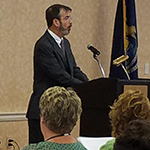Florida Governor Issues Order Requiring Immediate Notice of Pollution Incidents
 Florida Gov. Rick Scott last week ordered the Florida Department of Environmental Protection (DEP) to develop new rules requiring public and private facilities “to provide notification of incidents of pollution within 24 hours to DEP, local governments and the general public through the media.” DEP quickly issued an emergency order increasing notification requirements for pollution incidents, as well as a notice of rulemaking to make it permanent after the emergency expires in 90 days. Under the new rules, facility owners must notify “local broadcast television affiliates and a newspaper of general circulation in the area of the contamination.” The rules significantly change the current “patchwork quilt of notice requirements,” according to an attorney writing in the Daily Business Review (registration required).
Florida Gov. Rick Scott last week ordered the Florida Department of Environmental Protection (DEP) to develop new rules requiring public and private facilities “to provide notification of incidents of pollution within 24 hours to DEP, local governments and the general public through the media.” DEP quickly issued an emergency order increasing notification requirements for pollution incidents, as well as a notice of rulemaking to make it permanent after the emergency expires in 90 days. Under the new rules, facility owners must notify “local broadcast television affiliates and a newspaper of general circulation in the area of the contamination.” The rules significantly change the current “patchwork quilt of notice requirements,” according to an attorney writing in the Daily Business Review (registration required).
Henninger Presents Public Notice Design Tips at Conference
 Ed Henninger (photo courtesy Stan Schwartz, NNA) challenged publishers to add some design spice to their public notices during his speech at PNRC’s Best Practices conference on Sept. 22 in Franklin, Tenn. “If you make public notices difficult to read and treat them like an afterthought, nobody is going to look at them,” he said. Henninger followed with a humorous, rapid-fire presentation offering the following ideas:
Ed Henninger (photo courtesy Stan Schwartz, NNA) challenged publishers to add some design spice to their public notices during his speech at PNRC’s Best Practices conference on Sept. 22 in Franklin, Tenn. “If you make public notices difficult to read and treat them like an afterthought, nobody is going to look at them,” he said. Henninger followed with a humorous, rapid-fire presentation offering the following ideas:
- Use a visual header in the public notice section (e.g., photo of the local courthouse)
- Publish the contact information of public notice personnel
- Use headlines to break up groups of public notices
PNRC Holds First Conference Devoted to Public Notice
 The Public Notice Resource Center’s premier public notice conference packed the room Sept. 22 on the first day of the National Newspaper Association’s Annual Convention in Franklin, Tenn. The half-day symposium featured panels on best practices, legislative strategy and the importance of publishing public notices on the web, and presentations on design and the state of public notice. The conference was sponsored by Tecnavia, Nevada Legal News and the Illinois Press Association.
The Public Notice Resource Center’s premier public notice conference packed the room Sept. 22 on the first day of the National Newspaper Association’s Annual Convention in Franklin, Tenn. The half-day symposium featured panels on best practices, legislative strategy and the importance of publishing public notices on the web, and presentations on design and the state of public notice. The conference was sponsored by Tecnavia, Nevada Legal News and the Illinois Press Association.
PNRC Issues Best Practices Guide
 The Public Notice Resource Center issued “Best Practices for Public Notice” on Sept. 22 at its first industry-wide symposium on public notice. The brief guide is based on research by PNRC that identified the practices that publishers must follow to protect newspaper public notice and the public’s right to know. It includes easy-to-read, graphical presentations of the best practices as well as the full document issued by the charitable organization, whose mission is to collect, analyze, and disseminate information on public and private notifications to the public through local newspapers, and to educate the public on the value and use of its right to know.
The Public Notice Resource Center issued “Best Practices for Public Notice” on Sept. 22 at its first industry-wide symposium on public notice. The brief guide is based on research by PNRC that identified the practices that publishers must follow to protect newspaper public notice and the public’s right to know. It includes easy-to-read, graphical presentations of the best practices as well as the full document issued by the charitable organization, whose mission is to collect, analyze, and disseminate information on public and private notifications to the public through local newspapers, and to educate the public on the value and use of its right to know.
New York Bill Allows Emailing of Meeting Notices to Newspapers
![]() Gov. Andrew Cuomo signed a new law clarifying that public meeting notices required by state law may be emailed to newspapers for publication. A review of the applicable law indicates the statute formerly stated merely that notice “shall be given to the news media.” The bill signed by Gov. Cuomo adds the words “or electronically transmitted” to the statute. “This is a positive step that will save time in getting notices to the media and therefore getting them out to the public,” the president of the New York State Town Clerks Association told the Albany Times Union. The new law also requires notices of government meetings that are live streamed to the public to include the web address of the site streaming the meeting.
Gov. Andrew Cuomo signed a new law clarifying that public meeting notices required by state law may be emailed to newspapers for publication. A review of the applicable law indicates the statute formerly stated merely that notice “shall be given to the news media.” The bill signed by Gov. Cuomo adds the words “or electronically transmitted” to the statute. “This is a positive step that will save time in getting notices to the media and therefore getting them out to the public,” the president of the New York State Town Clerks Association told the Albany Times Union. The new law also requires notices of government meetings that are live streamed to the public to include the web address of the site streaming the meeting.
Government Website Leaves Residents with Little Notice about Bee-Killing Zika Spray
 Many residents in Dorchester County, South Carolina were upset by the lack of notice from government officials about a recent aerial insecticide spray that killed millions of honeybees, according to USA Today. The county sprayed naled, which is harmful to bees and other insects, in order to kill mosquitos that are known to carry Zika.
Many residents in Dorchester County, South Carolina were upset by the lack of notice from government officials about a recent aerial insecticide spray that killed millions of honeybees, according to USA Today. The county sprayed naled, which is harmful to bees and other insects, in order to kill mosquitos that are known to carry Zika.
A local TV news station reported that many people said they had been notified by phone only 10 hours before the spray. County officials responded by noting that they had also posted a notice on the county website two days earlier.
Publisher Loses Public Notice Contract, Decides to Run Notices For Free
Calaveras County, California is in the throes of tumultuous change. Located in the Sierra Nevada foothills, the mountain community is considering whether to replace the 600 homes destroyed last year by wildfires with medical marijuana farms. The issue has opened a huge debate that has engaged many of the county’s approximately 45,000 citizens and led to a series a ballot measures.
It’s the kind of place that really needs its public notice.
PNRC President Speaks to County Clerks Group
 “Public notice is truly a partnership between newspapers and local government,” PNRC President Bradley Thompson told the Michigan Association of County Clerks at their summer meeting on Aug. 22 in Grand Rapids. “We both have mandates to do it properly.”
“Public notice is truly a partnership between newspapers and local government,” PNRC President Bradley Thompson told the Michigan Association of County Clerks at their summer meeting on Aug. 22 in Grand Rapids. “We both have mandates to do it properly.”
Thompson (photo on left courtesy of Michigan Press Association), chairman and CEO of the Detroit Legal News Co., used the remainder of his speech to define what proper public notice entails, and to place it in context as part of the three-legged stool of transparent government: Public notice, open meetings and freedom of information.
Print Wins One; Wall Street Journal Chalks It Up to Lobbyists
The national media tend to operate in internet-saturated media environments and often overlook the value of print to key constituencies. As a result, Consumers for Paper Options, an organization funded by the paper and mailing industries, has an uphill battle to be heard as it tries to preserve the ability of the public to read information on paper.
Texas Water Supplier Cited; Has History of Public Notice Violations
The Dog Ridge Water Supply Corp. was cited by the Texas Commission on Environmental Quality (TCEQ) on Friday for failing to collect a sufficient number of samples required as a result of earlier tests that showed the presence of E. coli and coliform bacteria, according to the Temple (Texas) Daily Telegram. The company, which supplies drinking water to approximately 4,500 people in Bell County, purchases its water from the Central Texas Water Supply Corp. The Daily Telegram reports that both Dog Ridge and its supplier have been cited for multiple violations by TCEQ for failing to follow the state’s public notice requirements.

